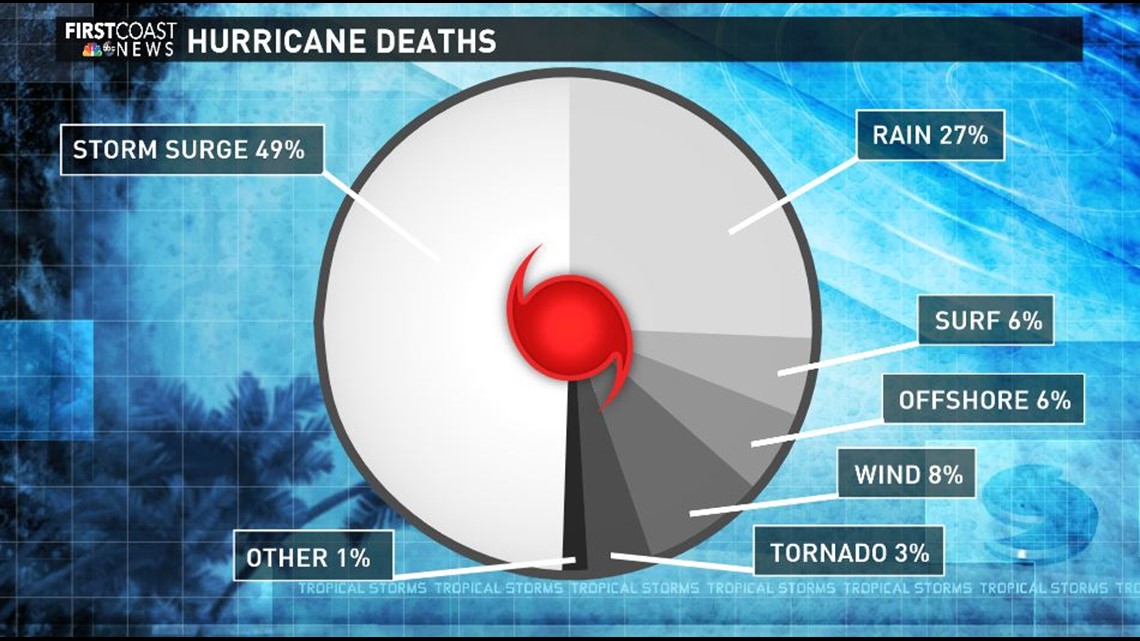When there's a storm, its maximum sustained winds tend to be the big focus when it comes to its strength and potential for damage. However, it's actually the water that can be the number one killer during a hurricane -- and that's because of storm surge.
Storm surge is often considered the greatest threat to life and property during a hurricane, according to the National Hurricane Center. Hurricane Katrina is a perfect example of how devastating storm surge can be. At least 1,500 people died from flooding in New Orleans, which resulted from storm surge, the NHC said.
So what exactly is storm surge? How many feet of storm surge can we expect from Hurricane Dorian? Which areas of the First Coast are most vulnerable? Our Storm Experts and Meteorologists Tim Deegan and Steve Fundaro break it down.


What is a storm surge?
Simply put, storm surge happens when a storm (like a hurricane) creates strong winds that push water onshore, higher than the normal tide. This could cause (extreme) flooding even prior to a storm's landfall, especially in coastal areas.
STEVE: "What storm surge does, is creates a brand new water level. So a 4-foot storm surge would make the new 'normal' water level at 4-feet. Wave heights would go on top of that; so a 6-foot wave on a 4-foot surge would be 10-feet high. Same applies with tides, a high tide of 2-plus feet would create water levels of 6-feet during a 4-feet surge."
What storm surge can we expect from Hurricane Dorian?
TIM: "Let's suppose that, in fact, the hurricane, Hurricane Dorian, the eye-wall stays just offshore. But because it's so powerful, and because it could be so close to where miles matter, we're still looking at potentially a 4 to 7 foot storm surge for Flagler and St. Johns [counties]. Maybe 4 to 6 [feet] in Duval, and points all the way north into Brunswick."


What parts of the First Coast should worry about a storm surge?
It's tough to prioritize storm surge zones and talk about timing, but we can clarify ALL areas that are susceptible to surge: Essentially, anywhere that's connected directly or indirectly to the ocean, which includes most of the First Coast because of the ocean, St. Johns River and all its estuaries.
TIM: "So what does that all mean? It doesn't necessarily mean we focus on the oceanfront. In fact, areas that extend from St. Augustine all the way down that are most sensitive to the storm surge, are along the Intracoastal.
"So we're talking Davis Shores, Downtown St. Augustine... As we go up into Duval, all these neighborhoods from Marsh Landing to the Sanctuary, both sides of the Intracoastal, Holiday Harbor, westside of the Intracoastal, eastside of the Intracoastal. All of those neighborhoods.
"If you were here during Matthew, and all the way up to Nassau County, Camden County and even you folks in Brunswick ... through the Golden Isles."
STEVE: "[Other] specific areas include the Black Creek in Middleburg, Trout River on the northside of Duval & St. Marys River."
TIM: "And although it may not be, we don't forecast [storm surge] to be devastating, it could still be significant to your neighborhoods."
If you want a good gauge for storm surge concerns, know your evacuation zone. Evacuation zones are heavily weighted on surge and flooding.

